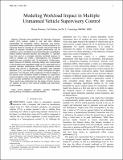Modeling Workload Impact in Multiple Unmanned Vehicle Supervisory Control
Author(s)
Donmez, B.D.; Nehme, C.; Cummings, M.L.
DownloadIEEE_Donmez_Nehme_Cummings.pdf (305.1Kb)
Metadata
Show full item recordAbstract
Discrete event simulations for futuristic unmanned vehicle (UV) systems enable a cost and time effective methodology for evaluating various autonomy and human automation design parameters. Operator mental workload is an important factor to consider in such models. We present that the effects of operator workload on system performance can be modeled in such a simulation environment through a quantitative relation between operator attention and utilization, i.e., operator busy time used as a surrogate real-time workload measure. In order to validate our model, a heterogeneous UV simulation experiment was conducted with 74 participants. Performance based measures of attention switching delays were incorporated in the discrete event simulation model via UV wait times due to operator attention inefficiencies (WTAI). Experimental results showed that WTAI is significantly associated with operator utilization (UT), such that high UT levels correspond to higher wait times. The inclusion of this empirical UT-WTAI relation in the discrete event simulation model of multiple UV supervisory control resulted in more accurate replications of data, as well as more accurate predictions for alternative UV team structures. These results have implications for the design of future human-UV systems, as well as more general multiple task supervisory control models.
Date issued
2010Publisher
IEEE Systems, Man, and Cybernetics, Part A Systems and Humans
Citation
Donmez, B.D., Nehme, C., & M.L. Cummings, Modeling Workload Impact in Multiple Unmanned Vehicle Supervisory Control, IEEE Systems, Man, and Cybernetics, Part A Systems and Humans, Vol. 40, Issue 6, p. 1180-1190, 2010.
Keywords
Attention allocation, operator utilization, queuing theory, simulation, unmanned vehicles